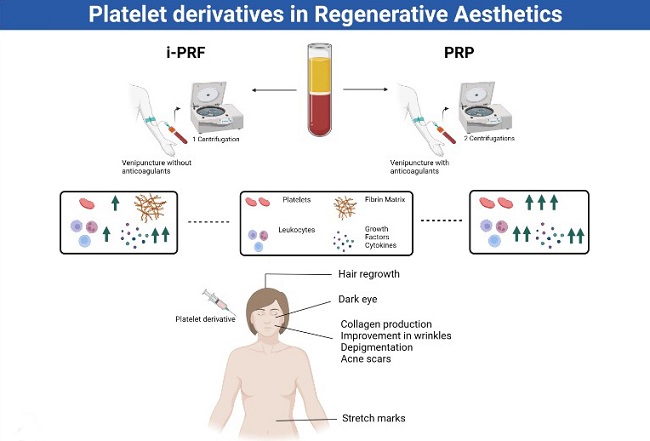Aesthetic News: The Revolutionary Use of Platelet Derivatives in Regenerative Aesthetics
Nikhil Prasad Fact checked by:Thailand Medical News Team May 23, 2024 10 months, 3 days, 3 hours, 54 minutes ago
Aesthetic News: In the rapidly evolving field of regenerative aesthetics, bioproducts derived from platelets, such as platelet-rich plasma (PRP) and platelet-rich fibrin (PRF), are making significant waves. These products, extensively researched and applied in various medical specialties, are now prominently featured in dermatology and aesthetic procedures. The application of these bioproducts has grown due to their potential to stimulate tissue regeneration, making them invaluable for treatments ranging from hair restoration to scar and striae management. This
Aesthetic News explores the innovative uses, benefits, and scientific backing of platelet derivatives in the realm of aesthetics based on a study review by researchers from Hospital das Clínicas de Goiás-Brazil, Brazilian Institute of Regenerative Medicine (BIRM), State University of Campinas (UNICAMP)-Brazil, Max Planck University Center (UniMAX)-Brazil and Anna Vitória Lana Institute (IAVL)-Brazil.
 Graphical Abstract - Revolutionary Use of Platelet Derivatives in Regenerative Aesthetics
The Science Behind Platelet Derivatives
Understanding PRP and PRF
Graphical Abstract - Revolutionary Use of Platelet Derivatives in Regenerative Aesthetics
The Science Behind Platelet Derivatives
Understanding PRP and PRF
Platelet-rich plasma (PRP) is an autologous preparation derived from whole blood, where platelets are concentrated in a small plasma fraction. This concentrate carries essential growth factors like platelet-derived growth factor (PDGF), transforming growth factor-beta (TGF-β), and vascular endothelial growth factor (VEGF). These growth factors are crucial for regulating processes such as cell proliferation, differentiation, angiogenesis, and chemotaxis.
In contrast, platelet-rich fibrin (PRF) is a platelet concentrate developed without additives like anticoagulants and is produced under lower centrifugal forces. PRF enhances the distribution of cells and growth factors within the matrix, forming a fibrin clot shortly after injection, providing structural support and prolonged release of growth factors.
Mechanisms of Action
Upon activation, PRP and PRF form a fibrin network in a liquid state, releasing a plethora of growth factors that stimulate tissue regeneration. These factors promote cell proliferation, differentiation, migration, and the production of collagen and elastin. The result is enhanced vascularization and tissue remodeling, key processes in aesthetic applications such as alopecia treatment, scar reduction, and wound healing.
Aesthetic Applications of Platelet Derivatives
Hair Restoration
Hair loss, particularly androgenetic alopecia (AGA), affects millions worldwide. Traditional treatments like minoxidil and finasteride offer limited efficacy and have side effects. PRP, however, has shown promising results in promoting hair growth by extending the anagen phase (growth phase) of the hair cycle, enhancing follicular stem cell differentiation, and increasing perifollicular vascularization.
Mul
tiple clinical studies support PRP's efficacy in treating AGA. For instance, a randomized, placebo-controlled study with 52 patients showed significant improvements in hair density and diameter after PRP treatment. Another study involving 23 male patients reported substantial increases in hair count and density three months post-PRP treatment.
Skin Rejuvenation
The demand for aesthetic procedures, particularly for skin rejuvenation, has surged due to the aging global population. PRP has been extensively researched for its potential to address skin aging, influenced by intrinsic factors like genetics and extrinsic factors such as UV radiation and pollution.
PRP's growth factors facilitate tissue repair, increase cell proliferation, and support angiogenesis and cellular rejuvenation. In vitro studies have shown PRP can enhance collagen expression, remodel the extracellular matrix, and promote fibroblast proliferation.
Clinical Applications
PRP can be injected or topically applied, often combined with microneedling, to improve skin quality, texture, and tone. Studies have demonstrated PRP's effectiveness in treating periorbital wrinkles, melasma, and other pigmentation disorders. For example, a study on 30 female participants found significant improvements in periorbital dark circles and nasolabial folds after PRP treatment.
Acne Scars and Striae Management
Acne scars and stretch marks (striae) are common aesthetic concerns. PRP and PRF have shown potential in treating these conditions by promoting collagen and elastin production, thereby improving skin texture and appearance.
A study on atrophic acne scars compared PRP combined with microneedling to microneedling alone, showing superior results in the combined treatment group. For stretch marks, research has indicated that PRP can stimulate collagen and elastic fiber synthesis, reducing the appearance of striae.
Standardization Issues
One of the significant challenges in using PRP and PRF is the lack of standardized preparation protocols. Variations in centrifugation techniques and platelet concentrations lead to inconsistent results across studies. Efforts to establish consensus guidelines and standardized protocols are essential to overcome these challenges.
Comparative Effectiveness: PRP vs. PRF
Recent studies have highlighted the comparative advantages of PRF over PRP in certain applications. For example, PRF has been shown to stimulate greater dermal fibroblast cell migration, proliferation, and collagen synthesis compared to PRP. However, PRF's preparation requires more technical expertise, which could limit its widespread use.
Innovations and Technological Advancements
Technological advancements, such as automated processing systems, could enhance the standardization of PRP and PRF preparations, making these treatments more reliable and effective. Additionally, further research into the specific mechanisms and optimal formulations of these bioproducts will help refine their applications in aesthetics.
Conclusion
Platelet derivatives like PRP and PRF hold significant promise in regenerative aesthetics, offering minimally invasive treatments for various conditions, from hair loss to skin rejuvenation and scar management. Despite the challenges in standardization and variability in results, the growing body of evidence supports their efficacy and safety. As the field advances, collaborative efforts to establish standardized protocols and further research into the mechanisms and applications of PRP and PRF will be crucial in realizing their full potential in aesthetic medicine.
The study findings were published in the peer reviewed International Journal of Molecular Sciences.
https://www.mdpi.com/1422-0067/25/11/5604
For the latest
Aesthetic News, keep on logging to Thailand Medical News.
Read Also:
https://www.thailandmedical.news/news/platelet-rich-plasma-injections,-a-2019--aesthetic-trend-for-cosmetic-facial-procedures-shows-promising-results
